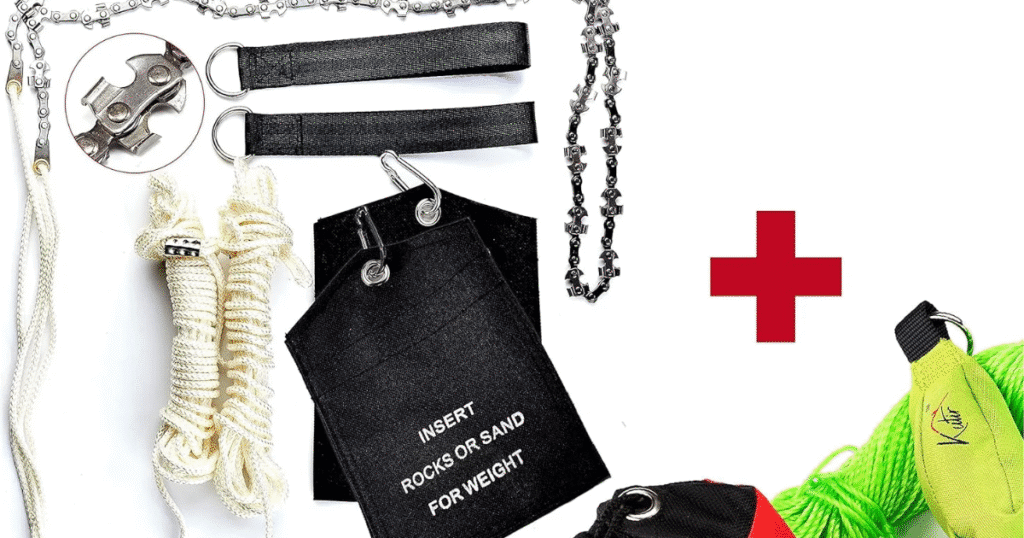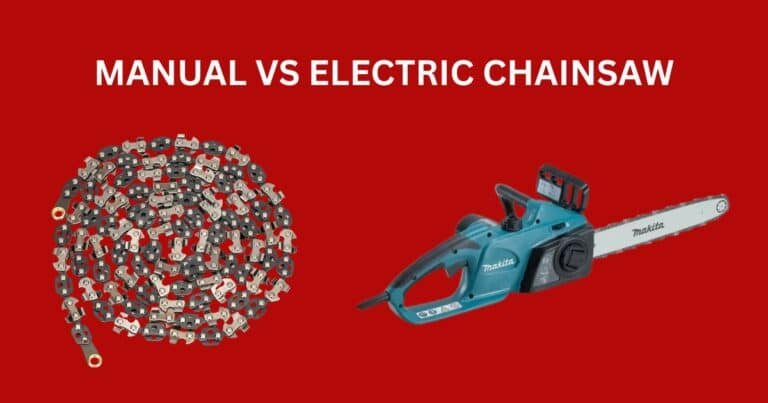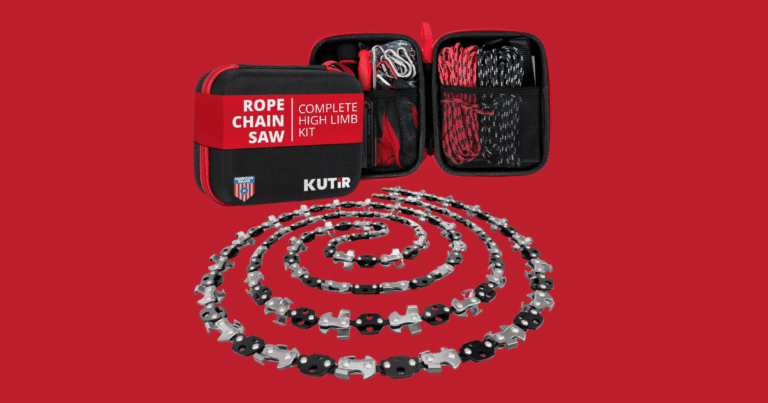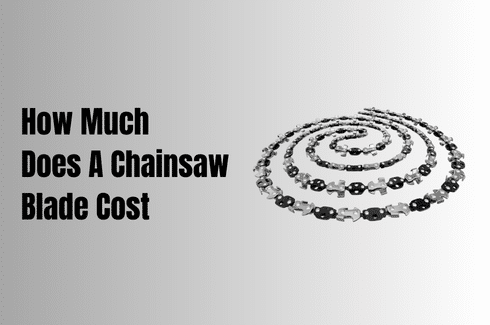If you’ve ever struggled with trimming high tree branches while balancing on a shaky ladder, you’re not alone. The hand rope chainsaw is the solution you’ve been waiting for. These tree limb cutting tools make cutting limbs from the ground a breeze, offering both safety and control without the risk of falling. Perfect for beginners, it’s simple to set up and use. No climbing, no complicated setups.
At Kutir Tools, we design high-quality, reliable tools that empower you to take on any task with confidence. Want to learn how to use a hand rope chainsaw like a pro? Keep reading to learn everything at our effective beginner’s guide to using a hand rope chainsaw safely.
What is a Hand Rope Chainsaw?

A Hand Rope Chainsaw is a cutting tool designed to help you trim high tree limbs without climbing a ladder. It consists of a chainsaw attached to a rope, which you control by pulling the rope to activate the chain.
This design allows you to stay safely on the ground while reaching branches up to 48 inches high, depending on the model. It’s lightweight and easy to use, making it ideal for homeowners and beginners who want to manage tree maintenance.
The tool offers better control and precision, making it a safer alternative to traditional ladder-based cutting methods.
Why Use a Hand Rope Chainsaw Instead of a Ladder?
A hand rope chainsaw provides a safer, more efficient alternative to using a ladder for high-limb tree cutting. Here’s why it’s the better choice:
Enhanced Safety
With a hand rope chainsaw, you stay on the ground. No risk of falling from a ladder or losing balance, making the cutting process much safer.
Easy to Control
The rope mechanism allows for precise control of the chainsaw. You can make steady, controlled cuts without the instability that comes with using a ladder.
More Reach
The 48-inch reach of a hand rope chainsaw lets you cut higher branches without needing to reposition or extend yourself, unlike a ladder that can be cumbersome to move.
No Need for Ladders
Ladders can be difficult to stabilize and dangerous on uneven ground. A hand rope chainsaw removes this concern, providing a stable cutting experience.
Ideal for Beginners
Using a ladder requires skill and confidence. A hand rope chainsaw is user-friendly, making it ideal for those new to tree trimming or without ladder experience.
Essential Safety Precautions Before Using Hand Rope Chainsaw

Using a hand rope chainsaw is a safe and efficient way to trim high tree limbs, but safety must always be a priority. Here are essential precautions to follow before starting:
Assess the Tree and Branches
Before using your hand rope chainsaw, carefully examine the tree. Look for branches that are strong and stable. Avoid cutting large or overly high branches that may pose a risk of breaking. Check for cracks or weaknesses in the branches, as these can cause the limb to fall unexpectedly.
Clear the Area
Safety starts with your surroundings. Make sure the area around the tree is clear of obstacles, tools, or other people. This reduces the risk of injury from falling branches or debris. Clear any leaves, twigs, or brush that might obstruct your movement while cutting.
Wear Proper Safety Gear
Safety gear is crucial when using a hand rope chainsaw. Wear protective gloves to avoid injury from the chain or rope. Safety goggles are essential to protect your eyes from flying debris. Sturdy footwear with good traction is necessary to keep you grounded while cutting.
Test the Rope and Chain Mechanism
Before starting, test the rope and chain mechanism to ensure it works smoothly. Make sure the rope is not tangled and moves freely. The chain should be sharp, not worn out. A dull chain will make cutting harder and can cause accidents due to the excessive force needed.
How to Use a Hand Rope Chainsaw? [Beginners’ Guide]
Now that you’ve followed all the necessary safety precautions, you’re ready to start using your hand rope chainsaw.
Below is a step-by-step guide on how to use a hand chainsaw for an effective cutting process.
Step 1: Position Yourself Safely
The first step before using your hand rope chainsaw is to position yourself correctly. Stand at least 10 to 15 feet away from the tree to give yourself enough space to work without getting too close to falling branches.
Your feet should be shoulder-width apart to keep your balance steady. Make sure you are not standing directly under the branch that you plan to cut.
Step 2: Check the Rope Setup
Once you’re in position, check the setup of your hand rope chainsaw. Begin by untangling the rope if it’s knotted or twisted. It’s important that the rope moves smoothly without any resistance, so make sure it’s not caught on anything. Test the rope movement by gently pulling it to ensure it flows easily and without any snags.
Step 3: Align the Chainsaw with the Limb
Next, position the chainsaw directly in line with the branch you plan to cut. The saw blade should be aligned parallel to the branch, ensuring that you make a clean and even cut.
Make sure that you are holding the rope with both hands to maintain steady control over the chainsaw during the cutting process. This will help prevent the chainsaw from jerking or veering off course.
Step 4: Begin Cutting Slowly
Now, you’re ready to start cutting. Begin by pulling the rope slowly to activate the chainsaw. Do not rush or pull too quickly, as this can lead to uneven cuts or strain on the chainsaw. By making slow, controlled pulls, you’ll allow the chainsaw to work efficiently and smoothly through the limb.
Step 5: Keep an Eye on the Branch
While cutting, pay close attention to the branch and its position. Watch for any movement in the limb as you cut. If you notice the branch beginning to shift or bend unexpectedly, stop cutting immediately to reassess. Be aware of the direction the branch is likely to fall and make sure that no one is in the path.
Step 6: Complete the Cut and Step Back
Once the chainsaw has cut through the branch, step back immediately. Watch the branch as it falls to the ground to ensure it doesn’t hit you or any structures nearby. By stepping back, you’ll avoid being in the line of fire if the branch falls quickly or unpredictably.
Step 7: Inspect Your Work
After cutting the branch, take a moment to inspect your work. Look at the cut to make sure it is clean and even, with no jagged edges or rough areas. Check the tree to ensure the cut did not destabilize the surrounding area.
Expert Tips For Using Hand Rope Chainsaw To Safely Trim High Tree Limbs
Using a hand rope chainsaw effectively requires more than just following basic instructions. To help you maximize your safety and efficiency, here are expert tips that go beyond the obvious.
- Align the chainsaw at a slight downward angle to prevent binding. This allows the branch’s weight to assist the cut, making the process smoother.
- If the limb is out of reach, have someone steady the rope while you cut. This reduces the chance of tangling and offers more control.
- Maintain steady tension on the rope. Too much slack or sudden pulls can lead to a jammed chain or an uneven cut.
- For larger limbs, make several shallow cuts instead of one deep cut to reduce strain on the chainsaw and ensure cleaner cuts.
- Avoid cutting in windy conditions as branches can shift unpredictably, increasing the risk of an uncontrollable cut.
- Start with smaller branches first. This prevents larger branches from falling prematurely, which could destabilize the tree and complicate cutting.
- Before cutting, scan the ground below for hazards like rocks or tools. Falling debris can cause serious injury, so make sure the area is clear.
Common Mistakes to Avoid While Using Hand Rope Chainsaw
Let’s look at some of the most common errors people make and how you can avoid them to stay safe and effective.
1. Overstretching the Rope
You might think you can reach that higher branch, but stretching too far puts unnecessary strain on the rope and chainsaw.
How to Avoid: Don’t push yourself too hard. Make sure you can comfortably reach the branch before starting. If it’s too far, use a step stool or ladder.
2. Jerking the Rope Too Hard
Pulling the rope too fast or too hard is tempting when you’re eager to finish the job. This can cause the chainsaw to jerk, leading to uneven cuts.
How to Avoid: Take a deep breath and focus on a steady, controlled pull. Rushing the process only leads to mistakes.
3. Standing Directly Under the Branch
It’s easy to stand directly under the branch while cutting, but this is one of the most dangerous mistakes you can make.
How to Avoid: Always stand to the side of the branch you’re cutting. Think of it as positioning yourself in a way that gives you an exit route if the branch falls unexpectedly. Your safety should always come first.
4. Using a Dull or Damaged Chain
A dull chain won’t just make your cutting harder. It can also cause the chainsaw to slip or bind unexpectedly.
How to Avoid: Inspect the chain regularly before use. If you notice it’s dull or damaged, take the time to replace or sharpen it.
5. Cutting Without Proper Grip
Not holding the rope tightly or correctly can make the chainsaw difficult to control. If the chainsaw jerks, you could lose your grip and cause an accident.
How to Avoid: Always grip the rope firmly with both hands, ensuring full control. This will help you keep the chainsaw steady and make more precise cuts.
How To Keep The Chainsaw Sharp And In Good Working Condition?
A well-maintained chainsaw not only makes your job easier but also extends the lifespan of your tool. Here are some practical tips to keep your chainsaw in top shape.
- The chain becomes dull after multiple uses, making cuts slower and more difficult. Sharpen the chain after every few uses to keep it performing efficiently.
- Dirt and debris can accumulate on the chain, affecting performance. Wipe the chain clean after each use to prevent buildup and ensure smooth operation.
- Proper lubrication keeps the chain running smoothly and prevents excessive friction. Lubricate the chain and bar regularly with bar and chain oil, especially before each use. This reduces heat and friction, extending the life of both.
- Look for signs of damage, such as bent or broken teeth on the chain. Replace any damaged sections to prevent further issues and ensure efficient cutting.
- A clogged air filter can affect the performance of the chainsaw. Clean or replace the air filter regularly to allow the chainsaw to run at optimal efficiency.
- When not in use, store your chainsaw in a dry place, away from moisture. Hang it up or place it on a shelf to prevent damage to the bar and chain. Keeping it clean and stored properly helps avoid rust and ensures longevity.
In Closing
The hand rope chainsaw is a game-changer for anyone looking to trim high tree branches safely and efficiently. With the proper technique and a bit of practice, even beginners can tackle tree maintenance with ease. At Kutir Tools, we’re committed to providing top-notch tools that make your tasks simpler and safer.
Ready to take your tree trimming to the next level with the Kutir hand chainsaw? Explore our collection of premium tools and start cutting with confidence today. Don’t wait! Your perfect cut is just a rope pull away!
Frequently Asked Questions
1. Can I use a hand rope chainsaw on thick tree branches?
Answer: Yes, but it’s best for smaller to medium-sized branches. For thicker limbs, you may need a more powerful chainsaw or multiple cuts.
2. How do I know if my hand rope chainsaw is properly set up?
Answer: Check that the rope moves freely and the chain is sharp. Ensure the tool is securely assembled before starting the cut.
3. How long can I use a hand rope chainsaw before needing maintenance?
Answer: It depends on use, but you should inspect the chain after each use. Sharpen the chain regularly and check for any wear or damage.
4. Are hand rope chainsaws safe for beginners?
Answer: Yes, they are designed with safety and ease of use in mind. As long as you follow the proper safety precautions, it’s a safe tool for beginners.





